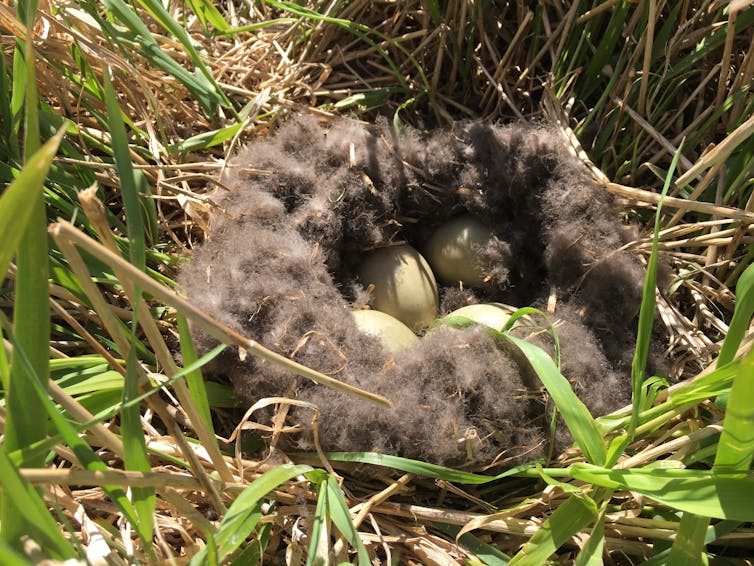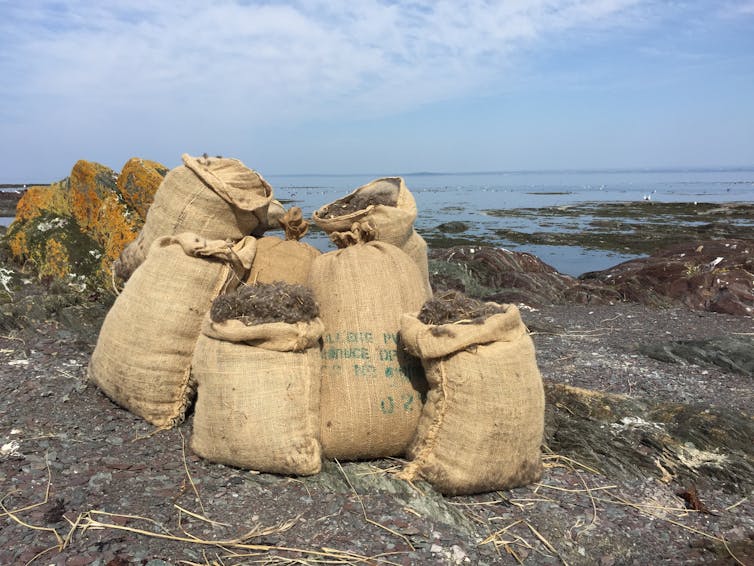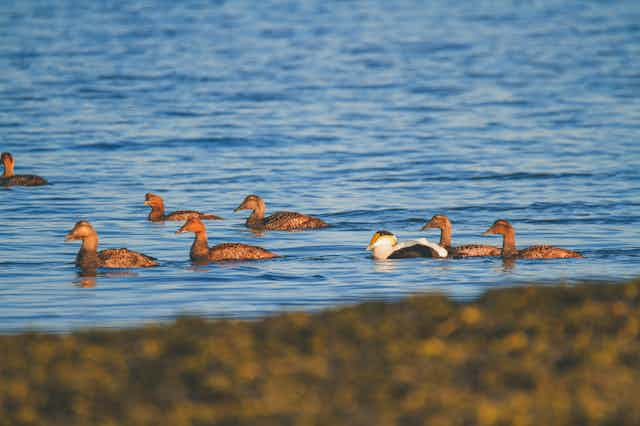The common eider is a sea duck that nests in colonies on islands along the North American coast from Maine to Labrador, and in the estuary and Gulf of St. Lawrence in Québec.
Eiderdown feathers cling to each other thanks to microscopic hooks on the barbs, the basic element of a down feather. The tangle of barbs, made up of barbules, traps air and give down its insulating power. These exceptional characteristics of eiderdown have been used for hundreds of years to make bed duvets.
In Canada, eiderdown harvesting is regulated by the Migratory Birds Convention Act. Collectors must obtain a permit from Environment and Climate Change Canada and follow a rigorous protocol when visiting a colony to minimize disturbances. Pickers must also record the number of nests they observe in a colony to help track eider populations.
As an associate professor in the department of biological sciences at Université du Québec à Montréal, I research the ecology and management of migratory birds, particularly ducks and geese. As a director of the non-profit conservation organization Société Duvetnor, I co-ordinate eiderdown harvesting operations in the St. Lawrence estuary islands.

This article is part of our series, The St. Lawrence River: In depth. Don’t miss new articles on this mythical river of remarkable beauty. Our experts look at its fauna, flora and history, and the issues it faces. This series is brought to you by La Conversation.
Down keeps eggs warm
Each colony has from a few dozen to a few thousand nests. Eiders share their nesting islands with herring gulls and sea gulls, which are predators of eider eggs and ducklings.
Females return year after year to the same island to nest and may reuse the same nest. Colony changes are very rare, hence the importance of protecting nesting islands. A female begins to nest at about age three and can live to 20 years.

Each female eider lays between four and six eggs in a nest on the ground that she lines with down to keep the eggs warm and camouflage them from predators’ view. By plucking the down feathers from their breasts, females expose an incubator plate that allows better heat transfer to the eggs to ensure embryo development.
Population monitoring
Since 2003, I have led a research project that aims to understand the population dynamics of estuary eiders. Members of my team join down gatherers in capturing and banding females as they leave their nests. Banding data make it possible to estimate, among other things, the survival and fidelity rates of females at the colonies. Our results showed that eider populations in the estuary are relatively stable.
Only one visit per colony is allowed per year, and harvesting must be synchronized with the end of incubation, which lasts an average of 26 days. Down cannot be harvested after nesting, as it quickly becomes soggy from dew and rain and therefore unusable. Hatching is fairly synchronous, and females leave their nest with their young no later than 24 hours after the last egg hatches.

In the St. Lawrence estuary, down harvesting was done in early June about 25 years ago. It now takes place at the end of May. This advance in the eider nesting season demonstrates the effects of climate change.
The team of gatherers must progress systematically through a colony without retracing their steps to allow the females to return to their nests, which they do within minutes or hours of the pickers’ passage.
The amount of down harvested from each nest varies according to the amount of down present. The rule is to leave enough down to cover the eggs, as a female would do when leaving her nest, which she does once a day to go drink. Unlike other duck species, female eiders do not feed during the incubation period. This particular behaviour is possibly the result of predation pressure by gulls on eider nests.
A luxury resource
Down harvested from colonies must be cleaned to remove twigs, feathers and other debris that end up in nests. In fact, only 15 to 20 per cent of the down harvested from a colony can be cleaned and made into duvets. It takes about 170 nests to produce one kilogram of clean down. Annual global production of eiderdown is between 4,000 and 5,000 kilograms, of which about 70 per cent comes from Iceland, 20 per cent from Canada and the rest from Greenland, Norway, Finland and Russia.

Considering that a duvet requires about one kilogram of down, it is clear that the annual production of duvets is very limited, hence the high price that can vary between $6,000 and $10,000 depending on the size of the duvet. The wholesale price obtained for the sale of down varies from year to year and can reach $1,500 per kilogram.
Reinvesting profits to protect the species
Société Duvetnor has been harvesting down from a dozen colonies in the estuary for 40 years. The revenues generated by down marketing have allowed Duvetnor to buy islands frequented by eiders and other seabirds species. That’s how Île aux Lièvres, the Îles du Pot à l'eau-de-vie and the Pilgrims’ Archipelago have been protected.

The income from down also permits Duvetnor to manage an ecotourism program that gives visitors an the opportunity to discover the islands of the Lower St. Lawrence River. Stays in inns, chalets or camping allow holidaymakers to observe, among other things, broods of eider ducks that feed on small aquatic invertebrates along the island shores.
This close contact with nature allows visitors to be aware of the importance of conservation of these natural environments, which are protected in part by the income generated by down.
The eiders are, therefore, making a real contribution to their own conservation.


